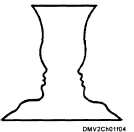Compositional Elements, Continued
Picture area or
Space inside the picture area exists as positive or negative space. Objects
picture plane
(Continued)
that dominate the eye occupy positive space. The space remaining is negative
space. Most pictures offer a primary object as a positive subject presenting a
complimentary design. Positive and negative space have nothing to do with
darkness or lightness or mirror images as they do in photographic media.
Beginning DMs usually concentrate on positive space and neglect negative
space. Failure to understand the terms positive and negative space results in
overcrowded, confusing images.
Figure 1-4 shows an example of positive and negative space. Is the image
you initially see profiles or a goblet?
Figure 1-4.
—Positive and
negative space.
Equal areas of positive and negative spaces create ambiguity. This contrast
competes for dominance and presents an unresolved visual state or conflict.
Figure 1-5 show the Chinese symbol, yin-yang. The symbol, a close balance
of a positive-negative visual state, is unresolved, leaving the impression of
constant moving or fluidity.
Figure 1-5.
—The
Chinese
symbol of
yin-yang.
Continued on next page
1-7



